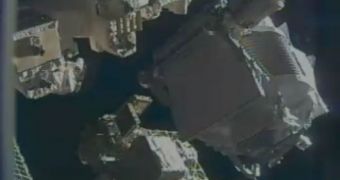The most complex and expensive scientific experiment ever delivered to low-Earth orbit has been installed on the exterior of the International Space Station (ISS) today, May 19. This is the last large component to be attached to the station by the Europeans and the Americans.
The Alpha Magnetic Spectrometer (AMS), which took $2 billion to construct, was installed on the outer hull of the ISS today, with help from the Canadarm-2 robotic arm. The instrument was designed and built by the Canadian Space Agency (CSA).
NASA's space shuttle Endeavour carried the AMS to the station. The orbiter took off on may 16 from the Launch Pad 39A facility at the Kennedy Space Center (KSC), in Florida, and docked to the ISS on Wednesday, May 18.
This is the last flight this spacecraft will ever carry out. The STS-134 mission also delivered some spare parts to the station, as well as supplies and personal items for the Expedition 27 crew.
Now that the AMS is installed, particle physicists will have access to the newest and most advanced particle detector ever built in space. The instrument is capable of capturing up to 10,000 hits from cosmic rays every minute.
Scientists hope that doing so will enable them to gain more insight into the nature of dark matter and dark energy. The two are believed to make up most of the Universe's matter and energy. Regular, baryonic matter accounts for only 4 percent of the Cosmos, physicists have determined.
“The most exciting objective of AMS is to probe the unknown; to search for phenomena which exist in nature that we have not yet imagined nor had the tools to discover,” explains the leader of the AMS project, Nobel Prize Laureate Samuel Ting.
He explains that one of the main missions of the AMS detector will be figuring out the origins of cosmic rays. Some of the leading candidates are the highly active regions at the core of galaxies or the particle accelerator-like magnetic fields that develop around supernova remnants.
“Significant European participation has gone into the AMS collaboration,” say experts at the European Space Agency (ESA), in a press release issued today.
“The instrument is a unique suite of different detectors and was mostly built in Europe by institutes in Italy, France, Germany, Spain, Portugal and Switzerland, together with the participation of US, China, Russia and Taiwan,” the document adds.
At this point, Endeavour is scheduled to undock from the ISS on May 29, and to return to the KSC on June 1

 14 DAY TRIAL //
14 DAY TRIAL //